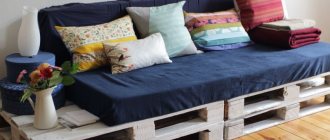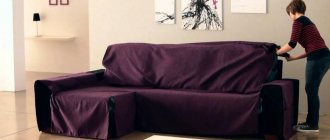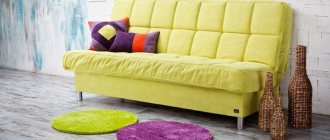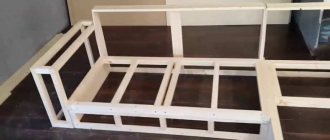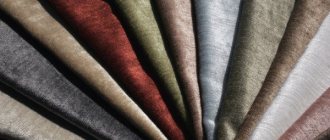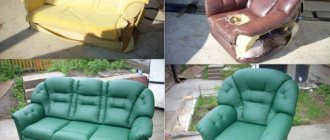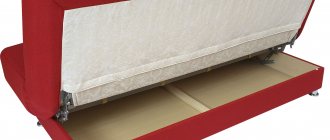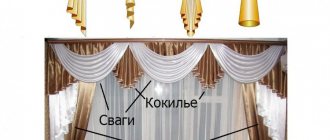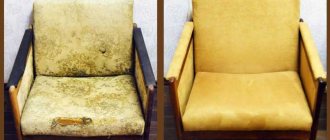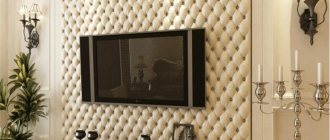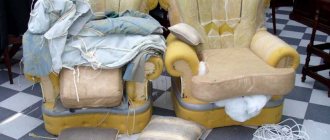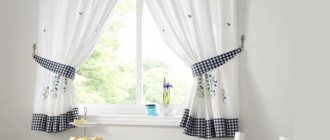Any housewife dreams of protecting her upholstered furniture from the negative impact of various factors. The desire not only to extend the life of your favorite sofa, but also to ensure cleanliness, cannot be realized without the use of covers. There are two options for solving this issue: you can either buy capes or make them yourself. Having studied the information on how to sew a sofa cover with your own hands: step-by-step instructions, even a person with no needlework experience will be able to carry out this creative work. A beautiful sofa cover can change the design of a room, decorating the interior and highlighting its individual details.
Purpose
When discussing the purpose of covers for upholstered furniture, it is appropriate to recall the expression that a problem is easier to prevent than to solve. Sofas and armchairs are an important and expensive part of home comfort. Their main disadvantage is the rapid wear of upholstery fabric and vulnerability to persistent marks from food, drinks, animal hair and cat claws.
After a home renovation, expensive furniture may not fit into the new interior or may simply become boring. Do-it-yourself sofa covers can solve all the above problems. It is fair to say that such coatings:
- protect factory upholstery from dirt;
- are a decorative element;
- help to fit old upholstered furniture into a new interior;
- allow the owners of the sofa to change its appearance, for example, depending on the time of year.
There are a number of arguments in favor of making cases with your own hands:
- Saving money.
- Possibility of individual measurements and tailoring.
- Availability of a wide selection of fabrics, textures and decor.
- The ability to frequently update the upholstery to suit the new interior.
- No fear of damage to the factory cover by children and animals.
Despite the fact that modern upholstery fabrics have become more durable and varied, they still have a certain wear resistance limit.
Protection against stains and fur
Stylish decor
Product Features
The fashion for removable covers arose a long time ago, but after the appearance on the market of services for reupholstering sofas and armchairs, they faded into the background. Nowadays, sewing furniture covers is gaining popularity again. This is due to the advent of modern wear-resistant fabrics and the advantages of the products themselves. Pros of cases:
- It’s easy to sew covers for sofas and armchairs yourself, without turning to specialists. There are different techniques, you can make a cape even without a pattern, so skills and experience do not matter much.
- The main purpose of the product is to protect existing upholstery from dirt, abrasion, stains, and fading.
- Those who like to periodically update their interiors will appreciate the ability to change the sofa cover when changing the color scheme or style of the room.
- When making a cape with your own hands, you can save on the services of a professional seamstress.
- Modern manufacturers offer wear-resistant fabrics of different densities, textures, shades, patterns, which allows you to choose the color of the cover for each occasion.
If there is a need to decorate the room for the arrival of guests, then it is enough to sew a beautiful “festive” cover, choosing a thematic design, for example, for the New Year or another celebration.
The ability of some fabrics to stretch causes cats to stop sharpening their claws on furniture. Other materials, for example, have a water-repellent effect. This cover will be indispensable if a festive feast is planned.
Protection of upholstery from dirt and fading
Opportunity to update the interior
Can be sewn even without a pattern
Handmade production saves budget
Large selection of wear-resistant fabrics
Choosing the right shape and design
Before you start sewing covers, you should take into account that furniture can have different shapes: rectangular, corner, shells. Sofa coverings must clearly correspond not only to the shape of the sofa, but also to its size.
All cases have their own functional varieties, depending on the purpose of their use. Let's look at the main options:
- Eurocase. It is sewn from a special textile material that can take any sofa shape. This fabric consists of special fibers with excellent elasticity. These capes are very practical. When sewing them, you do not need to take careful measurements of the sofa. They are perfect for corner models of any configuration.
- Covers with elastic are easily pulled onto the sofa and secured thanks to the sewn-in elastic. This covering is easy to make yourself, even without a pattern.
- Universal simple covers are made of elastic material. They are easy to make with your own hands. These sofa decks consist of two layers of special stretch textiles.
- Covers with a “skirt” at the bottom are frills located at the bottom of the product. When sewing, frills can also be made on the armrests. They are best suited for interior design in Provence and country style.
Eurocase
With a skirt
Universal
With an elastic band
As for the design of the sofa deck, it should match the overall style of the room:
- Bedspreads of complex shapes are suitable for avant-garde interiors. They are made from material with rich decorative filling: drawings, prints, inscriptions, three-dimensional elements.
- Products in the English style are able to completely cover the furniture, accurately conveying all its contours. They require special sewing precision. Often used in a duet with various types of fastenings. They have a laconic appearance.
- For country style, simple covers made from natural fabrics in their natural colors are suitable.
- Sofa decks for loft interiors are made in an urban style. They are simple and have a minimum of details. These covers are easy to care for. Non-marking fabrics are used.
- Bedspreads for a high-tech style sofa have a laconic design. Usually these are plain blankets in neutral colors.
Vanguard
In English style
Country
Loft
High-tech
Case latches, made with your own hands, come in different varieties. Buttons are especially suitable for rooms decorated with natural wood, when using floral ornaments. Velcro is suitable for covers in a nursery. The zipper is easy to use and is ideal for covering upholstered furniture in the office and living room. Ties look especially good in classic interiors.
Model selection
Models of sofa covers amaze with their diversity. There are products that completely hide pieces of furniture, making them seem flying and airy. They will be appropriate in the following styles - classic, English, modern.
If you are a lover of practicality and functionality, then you will like throws made to fit snugly on a sofa or armchair.
Here you will not see any decorations, such as bows, flounces and ruffles. But you will definitely like the pockets located on the side of the case and on the armrests. You can put glasses, a newspaper, a book in them.
In addition to furniture, capes can be sewn for various things - laptops, TVs, etc. A phone case for your hand looks interesting. Experiment and imagine. And you will create a truly unique decor.
Materials for production
Any sewing job begins with choosing fabric. When deciding what to make a sofa cover from, you should understand that its main function is to protect the upholstery from dust and dirt. For sewing use:
- Velor is a fabric that is soft and pleasant to the touch. It can be perfectly smooth, decorated with embossing or embroidery. Does not cause allergies and does not activate static voltage. Not afraid of the washing machine.
- Flock is a delicate and soft material. Contains polyester and cotton. It has high wear resistance and resistance to discoloration. Not afraid of direct sunlight and animal claws. It is waterproof.
- Microfiber is an excellent substitute for suede. This synthetic material comes from Japan. It has high strength. Does not cause allergies, easy to clean.
- Cotton is a natural “breathable” material. Ideal for children as it is hypoallergenic. Easy to maintain and clean. Does not accumulate static voltage. Disadvantages: wrinkles a lot, wears out quickly.
- Chenille - has a soft plush texture, but at the same time, durable and wear-resistant. Does not require complex care and is not afraid of the washing machine.
- Jacquard - produced using high-tech equipment. It is distinguished by its density and resistance to mechanical stress. Beautiful in appearance, ideal for living rooms and expensive interiors in classic, baroque, and empire styles. Not afraid of washing machine and dry cleaning.
Velours
Flock
Microfiber
Cotton
Chenille
Jacquard
Requirements for fabrics for sofa covers:
- Practicality.
- Hypoallergenic.
- No static electricity.
- A combination of softness and strength.
- Increased wear resistance.
- Availability of special water-repellent impregnation.
When choosing a material for sewing sofa covers yourself, you should take into account two important factors:
- Age of persons using the sofa.
- The purpose of the room where the furniture is located.
Designers recommend, taking into account the intended purpose of the room, using the following materials for covers:
| Purpose of the room | Case material |
| Children's and playrooms | Environmentally friendly and pleasant materials are needed. Such fabrics should be easy to clean. Velor, chenille, microfiber, cotton are suitable. |
| Living room | Materials must be practical to use, resistant to external influences and easy to maintain. Optimal options: leather, eco-leather, jacquard, velor, microfiber. |
| Bedroom | Suitable fabrics are damage-resistant, non-fading and environmentally friendly. For example, flock, velor, chenille, microfiber. |
For children's
For the living room
For the bedroom
How to determine size
To sew a cover, you need to take proper measurements of the upholstered furniture in order to understand how many parts the pattern of the future sofa cover will include, and what shape of the cover should be sewn.
There is the easiest way to sew a sofa cover with your own hands - this is to use an old cape, if it has been preserved. It is ripped into its component elements, and then the resulting parts are transferred to the surface of the new fabric.
The volume of material needed to sew a cover can be easily calculated using the following scheme: you need to take two lengths and add two widths of the sofa to it.
Table of the main sofa parts that require measurements when making a cover:
| Options | Explanations |
| Length | The distance from the point where the rear wall of the sofa touches the floor to the point where the front of the seat touches the floor. In other words, this is the height of the back of the back + the height of the front of the back + the depth of the sofa + the height of the seat. |
| Width | Distance from one armrest to another. |
| Armrest width | Distance from the point where the armrest meets the seat to the point where the armrest meets the floor |
| Armrest length | Distance between the edge of the armrest and the point where the armrest meets the backrest |
Step-by-step sewing instructions
Let's look at how you can sew a sofa cover with your own hands in step-by-step instructions. There are three manufacturing options:
- No pattern.
- We will reveal it locally.
- According to the pattern.
| Preparation method | Model features |
| Without pattern | An elasticated cover for a sofa can be made without a pattern. This will require a large amount of fabric, based on the following: the width is equal to five widths of the seat, and the length of the fabric is 3 times the length of the sofa. |
| Cut according to location | Sewing such a cover is simple and very profitable. It does not require a lot of fabric consumption and leaves little waste after work (about 20%). Suitable for standard shaped furniture only. This cutting option is used to sew a cover for a sofa without armrests (non-folding or folding book with mechanisms, accordion). |
| According to the pattern | It has undeniable advantages. The fabric area is fully utilized, the cover fits perfectly on the sofa, and is not only original, but also a unique product. |
It is not recommended to start sewing a cover with furniture of a complex configuration, with a large number of rounded lines: it is much more reasonable to make a pattern for a straight sofa. Practice on the material that is available in abundance (for example, use old curtains).
Without pattern
Materials and tools
To sew a sofa deck, you need to prepare the following set of tools:
- Scissors. They must be sharp so that when cutting the fabric, creases do not form.
- Set of sewing needles. With their help, you can fix the details of a paper pattern on the fabric of the future cover. The more needles, the more comfortable the process of cutting out product elements.
- Sewing machine. In addition to the stationary one, it is also convenient to have a manual machine to work in weight.
- Yardstick. Needed to take measurements of the sofa.
- A simple pencil. Required for paper marking.
- Piece of chalk. Needed for marking the surface of the fabric.
All of the above tools, with the exception of a sewing machine, are usually available in any home.
Tools
Pattern of parts
To sew your own sofa covers, you need to make patterns. If the sofa has a simple rectangular shape or a corner model with a wall and back of a standard rectangular shape, then making it will not be difficult.
A pattern for sewing a sofa cover with your own hands requires accurate measurements of each detail. Measurements must be placed on graph paper, taking into account the direction of the split line. Then you should transfer the calculations performed to the material using chalk.
The markings must be applied to the wrong side of the fabric, taking into account seam allowances.
To make a pattern, you can use ordinary newspaper sheets. Carbon paper will also work. It is used to cover all the components of the sofa, outline their shape, and cut out the parts using scissors. They are all then assembled using tape. The resulting pattern is corrected right on the spot: the cuts are connected with tape, and the missing gaps are increased with new paper inserts.
After everything has been checked and joined, you should proceed to the stage of cutting on the material:
- The fabric must be ironed. Cotton and wool materials should be washed in warm water so that they shrink and the finished product does not decrease in size.
- Then the fabric should be folded with the right side inward. Pin the drawings using safety pins.
- Use chalk to outline the contours of the paper. Stepping back about 2 cm, draw a second line.
- Cut out the parts along the contour of the second line.
The result is cut parts, and the sewing phase can begin.
Pattern for a sofa cover
On a straight sofa
On the corner sofa
Sewing
The made pattern and step-by-step instructions for sewing a sofa cover require adherence to clear instructions. Sewing must begin with the basting stage. Sewing includes eight main steps:
- Sew the resulting parts using a running stitch.
- Try on furniture.
- Check that the parameters of the cover match the dimensions of the sofa.
- Sew the parts using a sewing machine.
- Finish the internal seams with an overlocker.
- Cut and sew the lining (if needed), and then sew it to the finished cover.
- Treat the fastener areas and edges of the product.
- If desired, decorate the case with decor.
The final stitching of all the parts of the cover will take about an hour. The main difficulty is that all the elements are massive and difficult to move under the needle.
Sewing a cover for a corner sofa with your own hands is not an easy task. There are two main manufacturing options:
- If a corner section is attached, then you need to sew 5 covers: for the main section, an extension, for the back and two armrests.
- If the corner section is insertable (or the sofa has a solid structure), then a simple pattern of a cover for a corner sofa is made separately for the “wings” and the corner of the furniture. Then all the parts are sewn together from the wrong side.
A cover for a corner sofa has a peculiarity: it always needs to be sewn in parts.
When stitching parts, it would be wise to use pleated fabric to disguise the joint (but only professionals can do this). It is much easier to choose the color of the material for the cover so that the seam is visually lost.
There is a little trick: you can make the seam between the parts much more hidden if you make it taking into account the fit of the fabric. And if the cape is made of coarse fabric (for example, canvas), then all seams can be made to fit.
Sew with running stitch
Trying it on furniture. Sewing down the parts.
We process the seams
How to make armrests for a chair
olx.ua
In the process of reupholstering armrests, a universal approach applies, regardless of the type of furniture. The chair is covered in a similar way to a sofa. The structure is removed, a new cover is made, and the foam rubber is cut out. The side panel is then attached back. But there are certain nuances of covering the chair:
- It is advisable to retighten not only the handles, but also the seat. In any case, the new material will differ in color and appearance from the previous upholstery;
- You should cut a piece of foam rubber five centimeters thick and glue it to the plywood sheet of the seat;
- A construction stapler will help securely fasten the straps to the back;
- Foam rubber is used, one millimeter thick. From it you need to cut a part that will be five centimeters larger than the seat itself. Fix the padding polyester on it;
- Then put the upholstery fabric on the seat and attach it with a stapler. Afterwards, we attach the padding polyester with foam rubber to the chair parts;
- We install the seat and move on to the armrests. To secure the padding polyester, you can use aerosol glue. Then we put on the fabric, trim it or secure it with staples. The chair looks like new.
Sew a canopy for a crib with your own hands: pattern, diagrams and description
Sew felt potholders with your own hands: pattern, diagrams and description
Decoration options
To decorate a new sofa cover you can use:
- bows;
- ribbons;
- laces;
- decorative edging;
- patch;
- applique.
Such decorations give the stitched cover even more attractiveness and individuality. In addition to purely aesthetic problems, decor also solves camouflage problems, distracting from mistakes made when sewing a cover.
Despite the fact that today in specialized retail chains it is easy to purchase absolutely any decorative elements, from complex bows to gold monograms, when sewing a product yourself, it is reasonable to also make decorations for it yourself.
When decorating furniture, you need to take into account which room the sofa will be in and who will use it:
- If this is furniture for a children's room, then you should not decorate the covering with small and hard parts.
- If the sofa is for the dining room, then there may be no decor at all.
- If this is furniture for the living room, then there are no restrictions for decoration: everything depends only on desire and interior needs.
Decorative pillows are a wonderful and practical decoration for a sofa deck. If you sew covers on them from the same fabric, but in a different color, the result will be laconic and especially effective. A thematic trio made in the same style will look incredibly aesthetically pleasing: a sofa cover, decorative pillows and curtains.
Handmade covers for upholstered furniture come in different varieties. It is necessary to proceed from the target needs of users of furniture, interior design and taste preferences in color and decor. Before you begin the sewing process, you should choose a fabric and acquire all the necessary tools. A self-made sofa deck is unique and can rightfully be considered the pride of the owners.
With bows
With contrasting piping
With laces
Patchwork style applications
With ruffles and flounces
